JING MINORITY
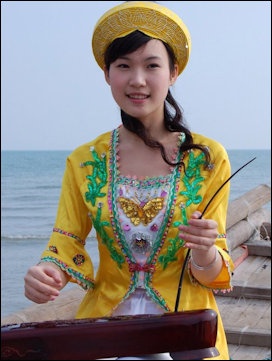
Jing girl playing a Jing musical instrument
The Jing (Gin) are a small minority that live near the China-Vietnam border. They are essentially a small group of Vietnamese living in China. They reside mainly on three islands in the Gulf of Tonkin —Wutou, Wanwei and Shanxin—in Jiangping County in Fangcheng in Guangxi Zhuang Autonomous Region. About one quarter of Jing live among the Han and Zhuang ethnic groups in nearby counties and towns. The origin of their language has not been determined. They have traditionally been fishermen who raised pearls and seahorses and were fond of chewing betel nut. Some are farmers. Land reclamation, encouraged by the state, has linked the islands to the mainland and made possible an expansion of agriculture. The main crops there are rice, sweet potato, peanut, taro, and millet. Tropical fruits like papaya, banana, coconuts and longan are also plentiful.[Source: “Encyclopedia of World Cultures: Russia and Eurasia/ China”, edited by Paul Friedrich and Norma Diamond (C.K. Hall & Company, 1994) |~|]
The Jing live in large villages, often with more than 200 households. Every village has small temples or shrines. The Jung practice Taoism with Buddhist elements. Villages generally have Taoist priests and male shamans, who help in healing and try to bring good fortune to their communities. Some Jing are Catholics.The shaman go into trances, purportedly when possessed by certain gods. According to the “Encyclopedia of World Cultures": The position usually passes from father to son. Their performances rely on written texts. There are also male shamans, who in trance are possessed by different gods. Both kinds of specialists are concerned with the success and safety of fishing, with illness and childbirth, exorcism of evil spirits, funerals, and the general well-being of the community.|~|
The Jings live in a subtropical area with plenty of rainfall and rich mineral resources. The the southern part of the Beibu Gulf near where they live has traditionally been a rich fishing ground. Of the more than 700 species of fish found there, over 200 are of economic value and high yields. In the past the Jing were primarily coastal fishermen but now venture out into the deep sea. Oyster farming is practiced. Sea horses are grow in abundance and are prized for their medicinal value. Seawater from the Beibu Gulf is good for salt making. Mineral deposits include iron, monazite, titanium, magnetite and silica. The large tracts of mangroves growing in marshy land along the coast are a rich source of tannin, an essential raw material for the tanning industry. [Source: China.org]
The Gin (Jing, Vietnamese) are the 43rd largest ethnic group out of 56 in China and the 42nd largest minority in China. They numbered 28,199 and made up 0.0021 percent of the total population of China in 2010 according to the 2010 Chinese census. Gin (Jing) population in China in the past: of the total population; 22,584 in 2000 according to the 2000 Chinese census; 18,915 in 1990 according to the 1990 Chinese census. A total of 12,140 were counted in 1982. [Sources: People’s Republic of China censuses, Wikipedia]
RECOMMENDED BOOKS: “Ethnic Minorities of China” by Xu Ying & Wang Baoqin Amazon.com; “Handbook on Ethnic Minorities in China” by Xiaowei Zang Amazon.com; “Minority Peoples of China” by OMF International Amazon.com; “China's Minority Nationalities” by Ma Yin (1989) Amazon.com; “China's Minority Nationalities” (1984) Amazon.com; China's Minority Nationalities” by Red Sun Publishers (1977) Amazon.com; “China's Ethnic Minorities” by Xiao Xiaoming Amazon.com; “Encyclopedia of World Cultures. Vol. 6, Russia and Eurasia/China” (1994) by Paul Friedrich and Norma Diamond Amazon.com; “Ethnic Groups in China” by Wang Can Amazon.com; “The 56 Colorful Ethnic Groups of China: China's Exotic Costume Culture in Color” by Xiebing Cauthen Amazon.com;
History, Religion and Language of the Jing
In the 16th century, the ancestors of the Jing moved to Guangxi from Tushan of Vietnam. At that time the group already had a history of nearly 500 years. The Jing were called the "Vietnam Nationality" in the past. In 1958,the ethnic group was formally named the Jing, According to to the Chinese government: “The Jings, who were all illiterate before 1949, are now going to school, and many young people have moved onto college education. Each village now has a clinic, and paramedics have been assigned to each fishing vessel.”
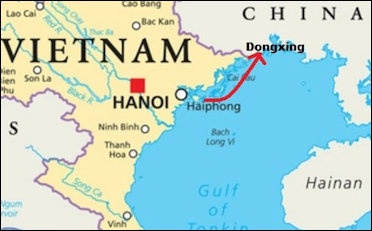
Origin of the Jing
The Jing have their own language, but it is still not decided which linguistic family it belongs to. They also speak the Cantonese dialect of Chinese. The Jing people had their own script which was called Zinan. Created on the basis of the script of the Han people towards the end of the 13th century, it was found in old song books and religious scriptures. Most Jings read and write in the Han script because they have lived with Hans for a long time.
Many Jings observe of Buddhism or Taoism, with a few being Catholics. The Jing also worship their ancestors and revere several gods, especially those who are involved with the sea. Whenever men go out to fish in the sea, old people, women and children all come to the seaside to see them off, and at the same time, some activities connected to the worship the God of Sea are held. [Source: Chinatravel.com]
Jing Changha Festival
The Jing celebrate most Han festivals, including the Spring Festival, Dragon Boat Festival and Mid-Autumn Festival, plus have a few of their own. Changah is generally the biggest. It is celebrated different times by different communities; honors ancestors and the gods of localized cults; and features singing, feasting and staging performances designed to entertain spirits. Festivals often feature the beating of drums and music made from a single string instrument that sits like a pedal steel guitar and is played standing up. [Source: “Encyclopedia of World Cultures: Russia and Eurasia/ China”, edited by Paul Friedrich and Norma Diamond (C.K. Hall & Company, 1994)]
During the Spring Festival, Jing families make Baishuyi, a kind of cake made from sticky rice powders with sugars wrapped inside. At breakfast on the first day of the first lunar month, the Jing do not drink wines or eat meat; they only have some porridge with sugar, sticky rice cakes and Baishuyi. Later people go to the Ha Pavilion to worship their gods and maker offerings of pigs, chickens and fish. After that they visit cemeteries to worship their ancestors. On Lunar New Year Eve they make sure to put some Baishuyi cakes before the shrines of their ancestors before going to bed.
The "Chang Ha Festival" is grandest traditional festival of the Jing people. "Chang Ha" in the Jing language means singing. There is a legend about the origin of the festival. In the Chen Dynasty of Vietnam, a singing immortal came to the Jing people’s area, where he mobilized Jing people to stand up against the ruling Chen Dynasty in the name of teaching songs and dance. Later, he had won the love and respect of Jing people, who built the "Ha pavilion" to commemorate him. Through the generations Jing sing praises of him. As time passed, the singing of these songs became the annual event, the Chang Ha festival. [Source: Liu Jun, Museum of Nationalities, Central University for Nationalities, Science Museums of China, China virtual museums, Computer Network Information Center of Chinese Academy of Sciences ~]

The date of the Chang Ha festival varies from region to region. It is on the tenth day of the sixth lunar month in Wanwei and Wutou; the tenth day of the eighth month in Shanxin. The center of the Chang Ha Festival is the Ha Pavilion. The pavilion is constructed with well-selected timber and is of a unique Jing style. Inside the pavilion are a God statue and memorial tablets of the ancestor. Before the festival comes, Jing people hurry to finish various kinds of work, then decorate their houses to receive guests. On the day of the Chang Ha festival, old and young, men and women dress in their nicest clothes attire and gather before the Ha Pavilion to hold the activities and offer sacrifices to the ancestors and greetings to the god, Chang Ha. Professional singers known as "Ha sisters" are invited. Meanwhile, other recreational activities are held. ~
The entire Chang Ha festival can roughly be divided into the following four procedures, with taking the seat and Chang Ha as the main part: 1) Greeting the god: On the eve of the Changha Festival, people welcome village gods, such as "King of Guarding the Sea" of Wanwei, in the "Ha Pavilion." 2) Memorial ceremony for the god: starts at about 3:00pm on the day of greeting the god. People hold various kinds of ceremonies. Kill "Yang Xiang" is first. The head hosting Chang Ha organizes the participants to raise a pig for each of them. The most heavy and fat pig is named, "Yang Xiang." After killing some is offered to Chang Ha, some of feasted on and some belongs to the owner. ~
3) Taking the seat: According to the custom, after the memorial ceremony for the god, every Jing man is allowed to take a seat as long as he has reached a certain age (12 years old in Wanwei, 18 years old in Wutou and 19 years old in Shanxin). They take their seats according to their status on the multilevel steps on the eastern and the western sides of the central hall in the pavilion. People drink and eat in a banquet, eight people at each table, while listening to the songs and watching the dance. The feasting generally lasts three days and nights. Women are not allowed to take the seats, and can only sit besides to hold the dish plates and listen to Chang Ha songs. 4) Seeing the god off: starts after the Chang Ha feast is over.
There are three main roles in Chang Ha song and dance dramas: a man called "Ha Brother," and two women called "Ha Sister." These three people are generally invited from Vietnam specially for the festival. Two "Ha Sisters" sings in turn, while "Ha Brother" accompanies them with musical instrument. The lead singer stands in the middle of the Ha pavilion, striking small bamboo clappers in her hand while singing. Another singer sits on the ground, with both her hands striking bamboo clappers, joining in the chorus. After the "Ha Sisters" finish one sentence, the "Ha Brother" plays a melody with his trichord. The two echo each other until the leading singer gets tired. Then the other "Ha Sister" stands up to be the lead singer. Chang Ha has its own songbook, generally written in "Nan" character. The content is colorful, covering national poems, legendary stories, and classical poems and love songs of the Han ethnic group.
Jing Marriage Customs
In the past the marriages of the Jing people were arranged by parents. However, nowadays young and women have the freedom to choose their own partners, of ten through a courting process that involves singing songs in an antiphonal style. After the singing activity, if a boy likes a girl, he will move toward her and sprinkle some sand on the ground near the girl using his toes. If the girl also likes the boy, she will sprinkle some sand back. The same thing can be done with tree leaves, [Source: Chinatravel.com\=/]
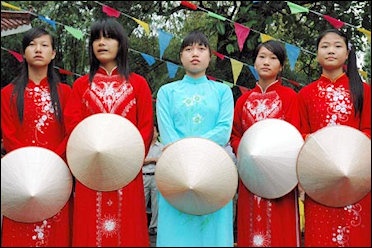
If a couple decides they want get engaged they invite a matchmaker to help them fix the marriage. They also give each other a colorful wooden shoe, and if it turns out that one shoe is for the left hand and the other is just for the right hand, that means that they are born to be lovers. When making the engagement, the boy's family send the girl's family a certain amount of pork and cakes as betrothal gifts. If the boy's family is poor, they can send a smaller amount of sticky rice, tea or cakes instead. When getting married, the boy's family has to prepare 50 kilos of pork, 40 kilos of wines, seven buckets of rice and some other gifts, and send them to the girl's family. Boiling pork for their ancestors when a girls get married is another custom of the Jing people. \=/
On the wedding day, the groom’s family, accompanied by some singers, goes to the home of to the girl's family to sing songs in an antiphonal style. The bride’s family closes the gate of their courtyard and sets up three more wooden gateways decorated with lanterns and flowers outside their house. In order to pass the three gateways, the boy's side has to sing songs with the girl's side until the latter is satisfied. After dinner, all of them go to the boy's family, where the bride and groom perform formal bows, which symbolize that they become husband and wife. After that singing activities are resumed and held all through the night. Three days after their wedding, the bride will go back to visit her family. The new couple prepares two trays with about six kilograms of red sticky rice, two chunks of pork, and two chickens to take to the girl's parents. This is the final event of the wedding ceremony. \=/
Jing Customs and Taboos
Religious activities are held every year whenever there are festivals, during which pigs, chickens and fish are offered to their ancestors. During the Changha Festival every year, all boys who are over 16 years old go to the Ha Pavilion for activities in which with some chickens, wine, sticky rice and betel nuts are offered. Only after this, are boys considered to have become adults. Then they are allowed to attend festival as adults, engage in courting activities and join the fishermen when they go out to sea. [Source: Chinatravel.com\=/]
There are some Jing taboos associated with fishing. One should not step over a fishing net placed on the beach or sit on a new boat before it has been launched. When visiting fishing families, guests should not say the word ' scorch' when they find that the food is overheated, as this word in Chinese has the same pronunciation with the word 'reef', which the Jing do not want their boats to hit. While on a boat, one should not say the word 'oil'—say 'slid' instead— as slid in Chinese has the meaning of smooth, success and going well, but oil has the same pronunciation with the word 'swim' in Chinese, implying only fishermen whose boats have wrecked have to swim. When moving utensils or other objects, instead of dragging them, people should carry them up in their hands or arms, because only the wrecked boats have to be dragged back. \=/
Jing Houses and Clothes
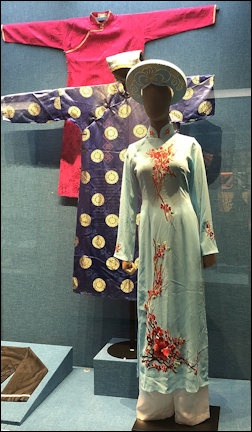
Jing clothes
The traditional house of Jing people is a thatched cottage, which they call a "Fence House." The wall is woven with bamboo strips, sometimes pasted with a layer of mud. Also, the wall can be made of thin bamboo strips inserted with cogon grass, straw, or leaves. In order to prevent the wind from blowing off the roof, the roof is covered with bricks or stones. Four bamboo or stone blocks, 20 to 30 centimeters tall, are erected in the four corners of the house. The house is separated into three small rooms with bamboo strips. The senior man and his wife sleep in the central room, and the children in the rooms on the left and right sides. [Source: Liu Jun, Museum of Nationalities, Central University for Nationalities, Science Museums of China, China virtual museums, Computer Network Information Center of Chinese Academy of Sciences ~]
After the People's Republic of China was founded in 1949, Jing people were encouraged to build "stone strips tile-roofed houses." The walls of these house are built with ashen, rectangle- shaped stones, each of which is 75 centimeters long, 25 centimeters wide, and 20 centimeters high. Twenty-three stone strips are built from ground to the head of the eaves and 10 stones are built from the head of the eaves to the top of the roof. The house is separated into three rooms, with a corridor in the front. Farming tools are placed by the corners of the corridor. The rooms on the left and right sides are the bedrooms. The central room is the main room, where ancestral tablets are hung on the wall. In addition to being a place where memorial ceremonies are held during festivals, the hall also acts as 'the sitting room," for receiving the guests, having meals, drinking tea, and chatting. This house is strong and durable, able to resist the wind and rain, and is suitable for the climate and life in the coastal area. ~
Jing people like to grow flowers and trees around their houses. Chinese ilex, sisal hemp, tree peony, cactus, as well as food plants like pineapple, papaya, and jute are get interweaved with each other. It looks like a seaside park.
Jing clothes are simple and practical. Traditionally, women have worn tight-fitting, collarless short blouses buttoned in front plus a diamond-shaped top apron and broad black or brown trousers. When going out, they put on a light colored gown with narrow sleeves. They also like earrings. Men wear long knee-length jackets and girdles. Now most people dress like their Han neighbors though a few elderly women retain their tradition and a few young women coil their hair and dye their teeth black from chewing betel nut. Jing women like to chew betel nut.[Source: China.org]
Jing Food
The staple food of Jing people is rice. On the New Year' Day and other festivals, they like eating polished glutinous rice and sweet porridge. The meat they have is mainly fish and shrimp. They are particularly fond of flavoring their food with “catfish juice”—a kind of fish sauce condiment The "Wind Blowing Cake"—cake prepared with glutinous rice mixed with sesame—is another favorite food of the Jing people. [Source: Liu Jun, Museum of Nationalities, Central University for Nationalities ~]
Most Jing people eat three meals a day but those living in the Wuwei area have only two meals a day, and they have breakfast usually around 11:00am and supper at dusk. In the past the main Jing meal was corn, sweet potatoes and taros mixed with a little rice. Nowadays, Jing people eat much more rice. The Jing people like to eat fish, shrimps, crabs and rice cakes. Pigs and chickens are also an important source of meat. A typical Jing food is fish soluble, also called silurid soluble. It is a traditional Jing condiment made from different kinds of small fishes pickled into a soluble form. [Source: Chinatravel.com \=/]
Fish soluble (also known as “catfish juice,” see below) is sold in the markets on Wanwei, Wutou and Shanxin. There, fishing families pickle small fishes from March to June every year. It is divided into three kinds: the first-class products, which are exported to the southeastern Asian countries; 2) the second-class products, usually sold in the domestic markets; and 3) the third-class products, kept by the fisher families themselves to eat. Even the last one is regarded as unforgettably delicious, so much so it can make an otherwise bland dish delectable. \=/
Catfish Juice and Wind Blowing Cake
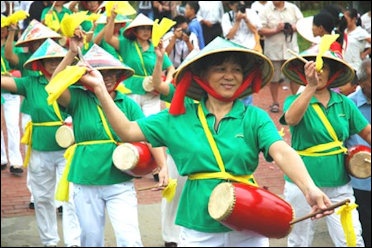
"Catfish Juice," also named "Fish Dew," is a sauce made of pickled small fish. Generally, it is made in the fishing season from the third month to the sixth month of the lunar calendar. Jing people earn a large income from selling catfish juice. Yellow and clear catfish juice is a favorite flavoring of Jing people. It also sells well Southeast Asiam countries such as Vietnam, Thailand, and Cambodia. Among the three islands, Shanxin Village has the largest output. It is known as the "Hometown of Catfish Juice." ~
To make it first fill up some straw and sand bags on the bottom of a large tile jar to be the filtering layer. On the bottom of the jar, holes are cut and a bamboo tube or rubber tube is set up to be the juice pipe. Put in salt and small clean fish layer by layer, in a proportion of 3:2. After filling the jar put a big stone on the top. After that, cover the jar and seal it. Five to seven days later, pull out the stopper of the juice pipe, from which the juice flows out continually. The juice that comes out at first is called "Initial Leaking Juice," which is very fragrant and with golden color. The delicious juice is the most superior type of catfish juice, and is used for receiving guests. After a while, add boiled salt water into the jar, and continue to press and strain the catfish juice. This produces the "Second-time Leaking Juice," whose color, fragrance and taste are slightly inferior to the "Initial Leaking Juice." But it is good enough quality to be widely consumed and exported to other countries. The juice is pressed and strained for a third time to produce "Third-time Leaking Juice," a third-class product, which is seldom sold in markets is used at home. ~
"Wind Blowing Cake" is made of rice. To make it: 1) Soak rice with hot water, then grind it into a thick liquid to be ladled on an aluminum tray with a diameter of 40-50 centimeters. 2) Spread it into pieces of thin film and place sesame on it. 3) Then put in onto a bamboo screen to be dried with charcoal fire. Because it is light and thin, and nearly transparent, it seems that it will fly up in the wind. That is why it is called "Wind Blowing Cake." Its flavor is fragrant and crisp. It can be cut into noodle-like threads and mixed with snail meat, crab meat, dried sipunculid worm and shrimp, and boiled into "cake-thread seafood soup," a tender, fragrant and sweet Jing delicacy served to guests. ~
Jing Music and Songs
Jing people like antiphonal songs which are melodious and lyrical. Their traditional instruments include the two-stringed fiddle, flute, drum and gong. Their single-stringed fiddle is a unique musical instrument. It has a 75-centimeter-long rectangular body made of half a piece of bamboo or three pieces of wood. One end of the instrument is bound with a small round column or metal piece which forms a right angle with the body of the instrument, and on the other end there is the knob on which the string is fixed. The Jing also have numerous folk stories and legends. Their favorite dances feature lanterns, fancy colored sticks, embroidery and dragons. Traditional Jing opera is called Chaoju. [Source: Chinatravel.com \=/]
The singing of the Jing is unique and special. For some types of songs young men sing while playing a three-stringed fiddle and two girls sing alternately while hitting the bamboo sticks and planks. The contents of the songs are mostly narrative epics and ancient Chinese poems and lyrics, such as Songzhen and Chen Juhua, the Legend of Killing the Dragon, the Fiddle Fairy and Seeing the Guest Off at the Bank of Xunyang River. There are folk songs, love songs, wedding songs, fishing songs, complaining songs, long narrative songs, folk customs songs and work and production songs. Some of the songs have been handed down from generation to generation with the same lyrics. Others are composed impromptu style when the Jing people recall old memories or are touched by the beautiful natural scenes. \=/
Folk songs of the Jing people deal mostly with the sea and productive activities associated with the sea. One Jing sea song goes: “People can not live without the sea no matter in rising tide or ebb tide, they can not live without the God of heaven either in spite of the blowing winds and disappearing sands, prints of ox hooves are scattered all along the road, people on fishing boats never stop working on the sea.” \=/
Singing antiphonal style singing (alternate singing by two choirs or singers) is an important part of the courting process for young Jing women and men. On sea-themed Jing love goes: “Row the boat on the sea until the paddles are nearly broken, what time can I reach the bank? The plank on the boat is too short to make a bridge for me to reach the bank, my love, please show your hands and pull me back to you.' \=/
Jing Fishing Culture
Fishing is a traditional industry of Jing people. Their fishing tools include drawing nets, Sai nets, Yu Bo, gill nets, as well as specialized nets such as shark nets, southern shrimp nets, jellyfish nets, horseshoe crab nets and cuttle fish nets. They also dig up sandworm, rake for spiral shell and catch crabs. Because of the differences in geographical and climate conditions, the kinds of fishing employed at a specific time varies throughout the year. Jing people have of knowledge about the sea and sea life. They are very familiar with the migration patterns of different fish and very good at using the marine tides and changes in the maritime climate to catch fish.[Source: Liu Jun, Museum of Nationalities, Central University for Nationalities, Science Museums of China, China virtual museums, Computer Network Information Center of Chinese Academy of Sciences ~]
Large drawing nets can be three meters tall and 400 meters long, composed of six silk fabric nets. The mesh is small and dense. Small drawing nets, are 330 meters long, 2.3 meters tall at both ends and 3.3 meters tall in the middle, and made up of four silk fabrics nets. When in operation, the large net needs thirty to forty people, while the small net takes twenty to thirty people. To use such nets: 1) learn to know the sea area, observe the fish's movements, and choose the best places; 2) row a skiff or bamboo raft to cast the net slowly in a place fish [ss through, creating a half-moon shape from the beach to the sea; 3) two groups of people hold the head rope on both ends and pull the net back to the beach; 4) in the course of dragging the net, the two groups draw close to each other slowly until the fish can be seen. Both Jing men and women participate in this operation. ~
The Sai net, also called the Zha Net, is divided into dense and sparse parts. Its length and height are about the same as the drawing net. However, the setup location of the net is on the beach. People are divided into three groups, and each group has people that: 1) "Mark the stake position," 2) "Insert the stake," 3) "Hang up the net," and 4) "Fill the string bag with sand”. The net is set up in advance before the tide comes. When rising, the tide carries various kinds of fish and shrimp into the net. After the tide ebbs, the fish and shrimp are trapped by the net and sand, "folding their hands for capture." The differences between the Sai net and drawing net is that the Sai net is placed in a fixed position and "drawing" net is draw, or pulled, in. ~
Yubo is a kind of funnel-shape fish trap, which is generally set up in place where the tide goes up and down and water moves rapidly. To make it two-meter-tall wooden stakes with a diameter of more than 10 centimeters are formed in two rows. Then small bamboo strips are used to make a "hedge" fence, enclosing a round “fish's room” about 3.5 meters tall. When the tide ebbs, fish, shrimp and crabs will enter the trap along the two rows of stakes. The shark net is a special net used to hunt sharks in the deep sea. It is 400 meters long and 1.3 meters tall, with large mesh. The net is made up of net thread, net floats (thick bamboo tubes), net falls (made of lead, iron or stone) and net head ropes. When casting the net, four people take a boat to a place of region of shark movement. The net sinks deep as a result of the heavy stones and is left in the sea for a few days.
According to the Jing custom of "Ji lai", if a person wants to eat seafood, they can go to a fully loaded fishing boat coming back from the sea and pick out some seafood to take away, and boat owner says nothing about it. The Jing also have some unique etiquettes, taboos and customs associated with fishing and the sea. If, for example, a meal has been burnt, people can't say " burnt," because "burnt" in Chinese sound like the word for "reef", and the Jing are afraid of hitting a submerged reef . On the boat, "oil" is called "Hua Shui," because "Hua" means "smooth." Every time the Jing men go to sea, the old men, women, and children will go to the beach to see them off and hold some memorial ceremonies for the sea.
Image Sources: Wikimedia Commons, People's Daily, Chinese government
Text Sources: 1) “Encyclopedia of World Cultures: Russia and Eurasia/ China”, edited by Paul Friedrich and Norma Diamond (C.K. Hall & Company; 2) Liu Jun, Museum of Nationalities, Central University for Nationalities, Science of China, China virtual museums, Computer Network Information Center of Chinese Academy of Sciences, kepu.net.cn ~; 3) Ethnic China *\; 4) Chinatravel.com \=/; 5) China.org, the Chinese government news site china.org | Chinese government, National Geographic, Smithsonian magazine, Wikipedia, BBC, and various books, websites and other publications.
Last updated October 2022
